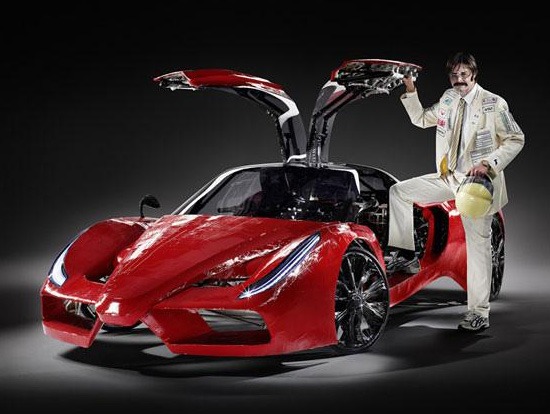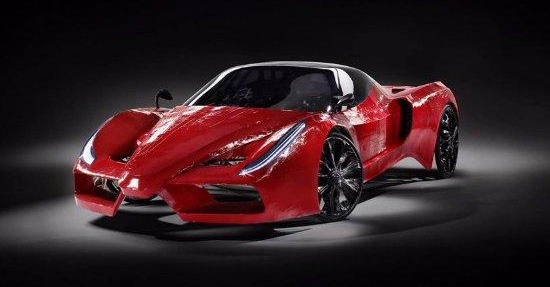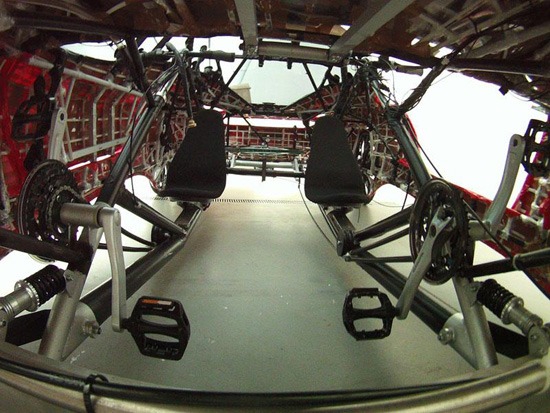
A Ferrarit és Michael Schumachert is kiparodizálja egy német mérnök, aki pedálhajtású Ferrarit alkotott.
A Fahrradi Farfalla FFX névre keresztelt autó formájú fekvőbringa egy vagy két személlyel is működhet, neve természetesen a német Fahrrad (kerékpár) és a Ferrari szavak összeolvasztásából keletkezett.

Alkotója az a Johannes Langader, aki korábban már egy szintén pedálhajtású szupersportkocsi, a Ferdinand GT3 RS megalkotásával vetette magát észre. Nem nehéz kitalálni, hogy az az autó egy Porsche 911-est mintázott.

A Fahrradi ugyanúgy készült, mint a Ferdinand: könnyű csöveket ragasztottak össze autó formájúra, aztán az egészet egy alumíniumcsövekből összehegesztett vázhoz rögzítették. Karosszériához a minta a Ferrari csak versenypályán használható szuperautója, a 700 lóerős FXX volt.

A rendkívül vicces sajtóanyag (lásd alul) szerint a jármű némán, egy pillangó súlytalan eleganciájával közlekedik.
A videón megtekinthető, hogy egy lábhajtású autóval is lehet fejjel lefelé mennie gy alagútban, pontosan úgy, ahogy Michael Schumacher tette ezt annak idején a Mercedes SLS AMG reklámfilmjében.
szólj hozzá: Fahrradi Farfalla FFX
szólj hozzá: SLS Mercedes reklám Schumival
Fahrradi Farfalla FFX
When Karl Marx stated in his Critique of Political Economy exactly 150 years ago that commodities had largely taken the place of relationships between persons and dominate us as phantasmagorical forms, he may not even have thought of the automobile, since experiments were still being conducted with steam or gas-driven motors. This was still nineteen years before the birth of the automobile in 1886. Yet there is hardly another object that has become so much of a fetish since then, serving to distinguish between power and impotence, rich and poor. Discussions about carbon dioxide emissions and particulate matter cannot prevent the car from triggering tremendous desires even today. It thus seems almost inevitable that now a further automobile model from the workshop of Johannes Langeder in Linz should be presented to the public, since the first, meanwhile already legendary Ferdinand GT3 RS was so extremely successful.
With the development of his new, ultimate super sports car, Langeder dares to look into the future, because unlike his imitation of the iconic 911, the new model is a kind of clairvoyant anticipation of a vehicle that is not yet even on the market. Fahrradi - the name is a clever combination of the German word for bicycle ("Fahrrad") and the reference brand, alluding to the essential principle of construction - is based on literally the same framework conditions as its predecessor: a perfectly imitated auto body made of light tubes and adhesive connections, which encases a bicycle construction as drive and slows down the approximately 700 HP of the previous model to 1 - 2 human-power. Johannes Langeder always sends his vehicles into real traffic, but instead of the expected sonorous motor noise, they move silently and with the weightless elegance of a butterfly. It is this surprise attack on existing patterns of perception, the deceptive play with bait and prey, disguise and discovery, that makes the artist's automobile objects so successful that they attract the interest of the most diverse audiences, from a gentlemen's magazine in Malaysia to a German cultural program, from an insert in a New York schoolbook to the British TopGear. The artist succeeds in revealing the most diverse connections to us at the same time: that the exchange of information seems to have become equivalent to the exchange of commodities and money in our information society and that it can be analyzed with the tested methods of theoretical economy, as Georg Frank explained in his Economy of Attention. Most of all, however, Langeder shows us that the tactic of an imitative magic enables a tactile recognition. The artist achieves a kind of magic mimesis, which is not coincidentally reminiscent of the practice of the shamans, in which the copy is intended to attract the power of the original (cf. Mimesis and Alterity by Michael Taussig).
The shamanic disguises that the artist likes to make use of, however, come entirely from our media world, such as when he drives his silent vehicle on famous racetracks wearing golden Rolex watches on both wrists like Burt Reynolds in The Cannonball Run. Ironically playing with roles and identities is a characteristic of Johannes Langeder's artistic practice. The high culture counterpart to the popular film figure was the role of the star conductor in a tuxedo, who began conducting the Linzer Philharmonie in 2000, an orchestra made up of a few trained musicians and many, less talented actors, from which he nevertheless demanded sophisticated achievements. Richard Wagner's Walkürenritt, symphonies by Beethoven and Mozart were performed in concert halls or radio halls. This role seemed to be custom-tailored for Langeder and seemed to confirm what Arnold Schönberg wrote to a French music lover in 1950: In my opinion, it is not the professional musician that is needed, the musician who lives from his art, in order to maintain musical culture. Rather, it is the amateur, and it has always been the amateur, who has supported the real cultivation of art. The reactions of the audience to the performances of the amateur orchestra also showed that Langeder succeeds in breaking open conventional patterns of perception with his mimicry tactic, subversively undermining existing cultural sign systems. The artist dons these contrary alterities, in a sense probing with the help of mimesis a sensuous knowledge in our time, a knowledge that in adhering to the skin of things through realist copying disconcerts and entrances by spinning off into fantastic formations (Taussig). Now we may encounter two such fantastic formations unexpectedly in city traffic: Ferdinand and Fahrradi.


Utolsó kommentek